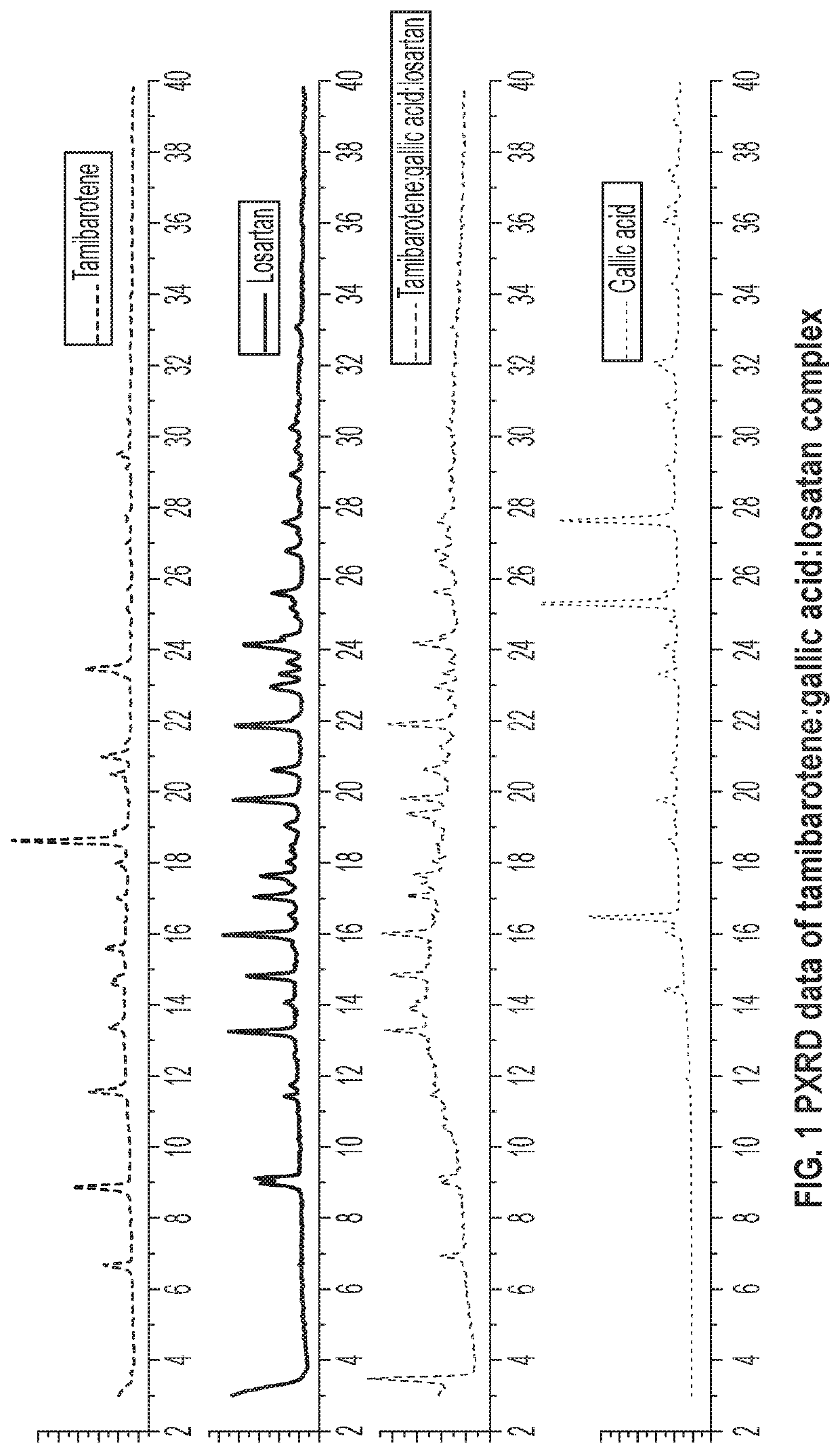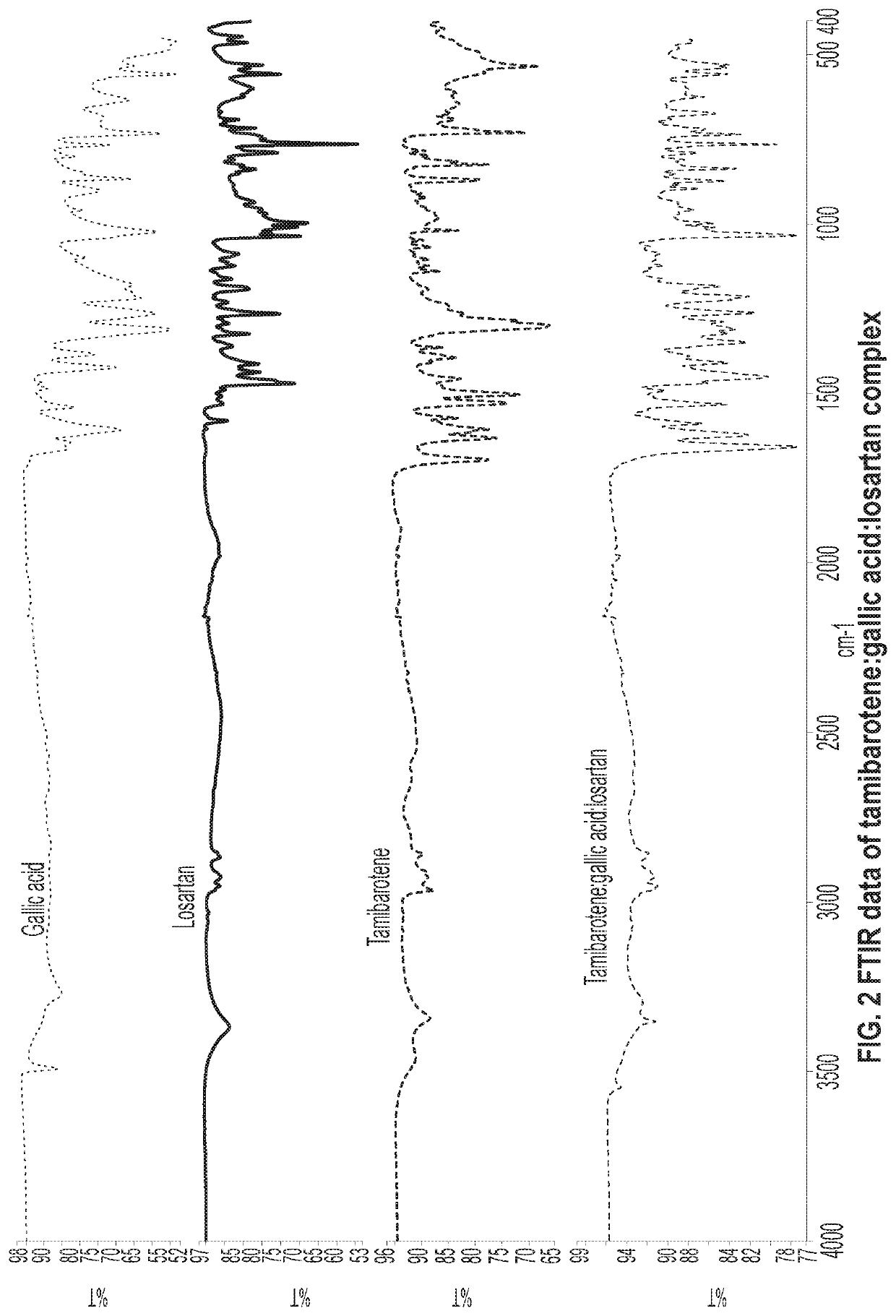Novel ternary molecular complex of tamibarotene for cancer stem cells treatment
a tamibarotene and stem cell technology, applied in the field of tamibarotene crystalline forms and pharmaceutical compositions, can solve the problems of unsuitable raw materials for pharmaceutical products, difficult preparation, and little information available on the manipulation of solid forms of tamibaroten
- Summary
- Abstract
- Description
- Claims
- Application Information
AI Technical Summary
Benefits of technology
Problems solved by technology
Method used
Image
Examples
example 1
on of Tamibarotene:Gallic Acid:Losartan Complex
[0065]30 mg of recrystallized tamibarotene in acetonitrile and 14.5 mg of gallic acid and 36 mg (1:1:1 molar ratio) was stirred as a slurry in an open 20 mL glass vial with 1 mL of acetone. After 12-16 hours the stirring was stopped, and the mixture was dried at room temperature for another 12-16 hours. The solids gathered were dried and stored in a screw cap vials for subsequent analysis. The material was characterized by PXRD and FTIR corresponding to FIGS. 1 and 2, respectively.
example 2
on of Tamibarotene:Gallic Acid:Telmisartan Complex
[0066]30 mg of recrystallized tamibarotene in acetonitrile and 14.5 mg of gallic acid and 44 mg of telmisartan (1:1:1 molar ratio) was stirred as a slurry in an open 20 mL glass vial with 1 mL of acetone. After 12-16 hours the stirring was stopped, and mixture was dried at room temperature for another 12-16 hours. Solids were dried and stored in a screw cap vials for subsequent analysis. All materials were characterized by PXRD and FTIR corresponding to FIGS. 3 and 4, respectively.
example 3
on of Tamibarotene:L-Malic Acid:Telmisartan Molecular Complex
[0067]30.0 mg of tamibarotene, 11.4 mg of L-malic acid and 43.5 mg of telmisartan (1:1:1 molar ratio) were stirred as an open slurry in 1 mL of acetone in a glass vial. After 16-24 hours of stirring mixture was further dried at room temperature until, a completely dried mixture is obtained. The resulted material was stored in a screw cap vial and characterized by PXRD and IR. See FIGS. 5, 6, 8, and 9. PXRD comparison of binary tamibarotene-L-malic acid complex (TN-513) with tamibarotene-L-malic acid-telmisartan (TN-513-T) also confirmed the successful synthesis of a ternary complex. Synthesis of ternary TN-513-T was scaled up to 150 mg of tamibarotene and stability was tested on accelerated conditions (75% humidity at 40° C.) for 1 and three months. Both scale up and stability studies confirmed that there is no change in PXRD data compared to the initial synthesis of TN-513-T. See FIG. 7.
Example 4: IC50 Studies
[0068]All IC...
PUM
| Property | Measurement | Unit |
|---|---|---|
| 2Θ | aaaaa | aaaaa |
| 2Θ | aaaaa | aaaaa |
| 2Θ | aaaaa | aaaaa |
Abstract
Description
Claims
Application Information
 Login to View More
Login to View More - R&D
- Intellectual Property
- Life Sciences
- Materials
- Tech Scout
- Unparalleled Data Quality
- Higher Quality Content
- 60% Fewer Hallucinations
Browse by: Latest US Patents, China's latest patents, Technical Efficacy Thesaurus, Application Domain, Technology Topic, Popular Technical Reports.
© 2025 PatSnap. All rights reserved.Legal|Privacy policy|Modern Slavery Act Transparency Statement|Sitemap|About US| Contact US: help@patsnap.com



